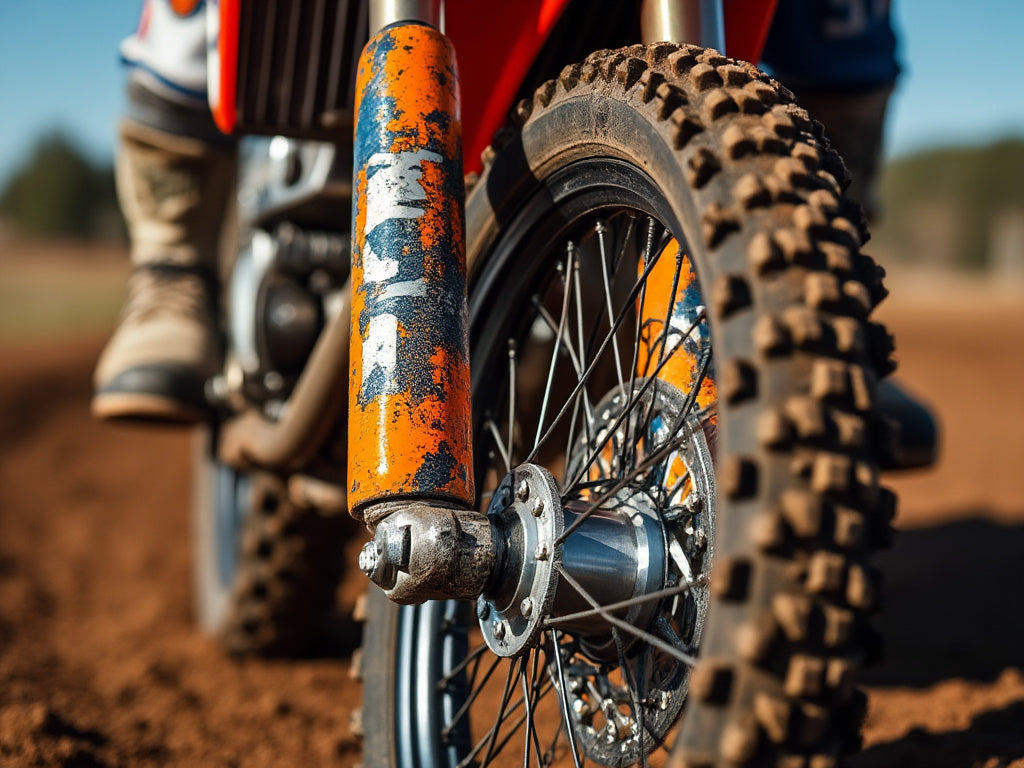
Published: 28.8.24
Proper suspension setup is crucial for maximising both the performance of your dirt bike and your riding experience.
While often overlooked, tailoring your suspension to your size and weight can significantly impact handling, comfort, and safety.
This guide will walk you through the process of adjusting your dirt bike suspension, ensuring that whether you're a lightweight freestyler or a heavyweight trail rider, your bike responds perfectly to your unique needs.
Understanding Suspension Basics

Before diving into adjustments, it's essential to understand the key components of your dirt bike's suspension:
-
Forks: These are the telescopic tubes at the front of your bike that compress when encountering bumps or landing jumps. They play a crucial role in maintaining front wheel traction and absorbing impacts.
-
Shock Absorber: This is the spring-loaded cylinder at the rear of your bike, responsible for managing impacts and maintaining rear wheel contact with the ground.
These components work in tandem to provide a smooth, controlled ride across various terrains. However, their effectiveness is highly dependent on proper setup for the rider's size and weight.
Determining Your Rider Category
Riders generally fall into three categories based on weight:
A smooth, technical rider may require different settings compared to an aggressive, high-speed rider, even at the same weight.
| Determining Your Rider Category | |||
|---|---|---|---|
| Category | Weight Range | Riding Style Considerations | Suspension Implications |
| Lightweight | Under 150 lbs (68 kg) |
|
May require softer springs and less damping |
| Average | 150-200 lbs (68-91 kg) | Standard suspension settings often cater to this range | |
| Heavyweight | Over 200 lbs (91 kg) | May need stiffer springs and increased damping | |
| Note: Your riding style and skill level play a significant role in determining the ideal suspension setup, even within the same weight category. | |||
Sag: The Foundation of Proper Suspension Setup
Sag refers to the amount your suspension compresses under load.
It's a critical measurement that affects your bike's handling characteristics.
There are three types of sag to consider:
| Understanding and Measuring Suspension Sag | |||
|---|---|---|---|
| Sag Type | Definition | Optimal Percentage | Measurement Process |
| Static Sag | Compression of the suspension under the bike's weight alone |
|
Equipment Needed:
|
| Race Sag | Compression when you're on the bike in riding position |
|
|
| Extended Sag | Difference between fully extended suspension and race sag | Calculated based on other measurements | |
| Note: Proper sag measurement is crucial for optimal suspension performance. Adjust preload to achieve the recommended sag percentages. Remember that rider weight, skill level, and riding style may necessitate slight deviations from these general guidelines. | |||
Spring Rates: Matching Your Weight
Spring rates are crucial for proper suspension performance.
They need to be matched to your weight to achieve the correct sag without excessive preload adjustment.
General guidelines for spring rates:
- Lightweight Riders: May require softer springs (lower rate)
- Average Riders: Stock springs are typically suitable
- Heavyweight Riders: Often need stiffer springs (higher rate)
The correct spring rate allows you to achieve proper sag with the preload adjusters set near the middle of their range.
This ensures you have room for fine-tuning in both directions.
Compression and Rebound: Fine-Tuning Your Ride
Compression and rebound damping control how your suspension reacts to impacts and how quickly it returns to its original position.
Compression Damping:
- Controls resistance to compression
- Too little can cause the bike to dive excessively
- Too much can result in a harsh ride
Rebound Damping:
- Controls how quickly the suspension extends after compression
- Too slow can cause the suspension to pack down over successive bumps
- Too fast can lead to a bouncy, unstable ride
Start with the manufacturer's recommended settings and make small, incremental adjustments.
Keep track of changes and their effects on your ride.
Adjustments for Extreme Sizes
Riders at the extreme ends of the size spectrum may need to go beyond standard adjustments:
- Shorter Riders: Consider lowering links or custom lowered suspension
- Taller Riders: May benefit from extended shock linkages
- Extreme Weight Differences: Custom valving might be necessary
In these cases, consulting with a suspension specialist can be invaluable.
They can provide tailored solutions that off-the-shelf components may not address.
Testing and Fine-Tuning
The true test of your suspension setup comes on the trail. After making adjustments:
- Ride on various terrain types
- Pay attention to how the bike handles different obstacles
- Keep a log of settings and their effects
- Make small adjustments and test again
Watch for common issues such as:
- Head shake: Instability in the front end
- Bottoming out: Using all available suspension travel too frequently
- Harsh ride: Excessive feedback from small bumps
Remember, finding the perfect setup is an iterative process that requires patience and attention to detail.
Conclusion: The Value of Proper Suspension Setup
While adjusting your dirt bike suspension for your size may seem complex, the benefits are substantial.
A properly set up bike will handle better, keep you safer, and significantly enhance your riding experience.
Suspension setup is both an art and a science. Don't hesitate to experiment, seek advice from experienced riders or professionals, and most importantly, enjoy the process of fine-tuning your ride.
With persistence and attention to detail, you'll find the sweet spot that makes your dirt bike feel like an extension of yourself on the trail.
Remember, the time invested in perfecting your suspension setup will pay dividends in improved performance and riding enjoyment.





Share:
The Difference Between a 2-Stroke and 4-Stroke Engine
10 Best Mods to Lower Any Motorcycle for Short Riders: A Comprehensive Guide